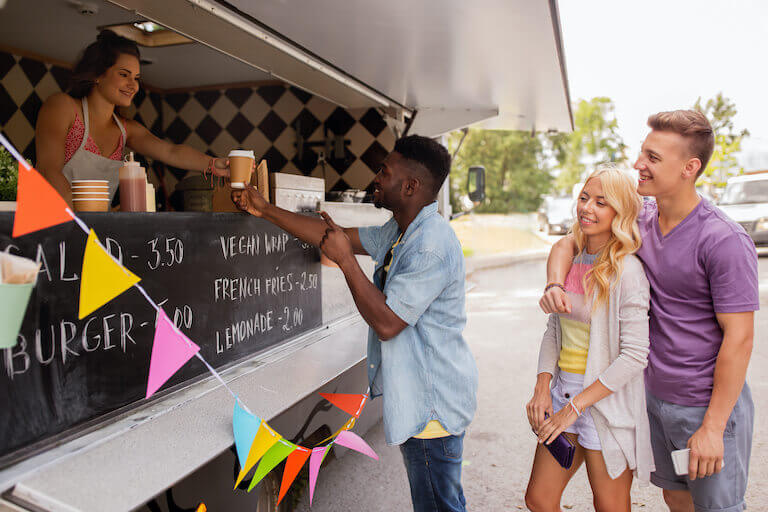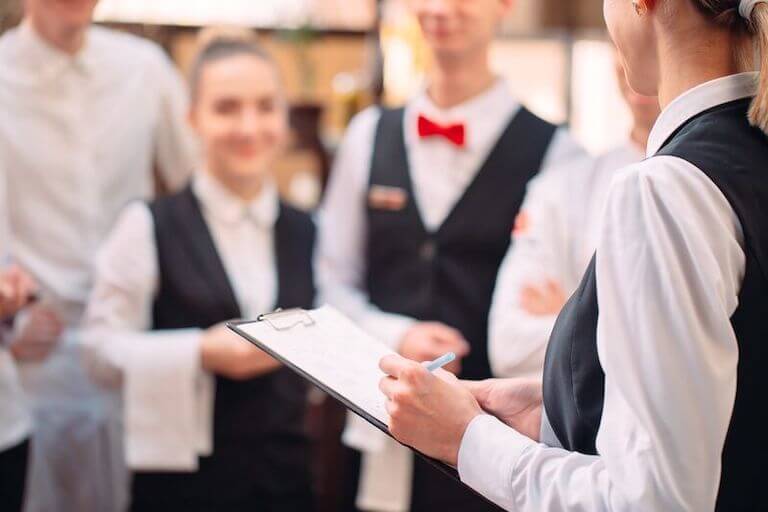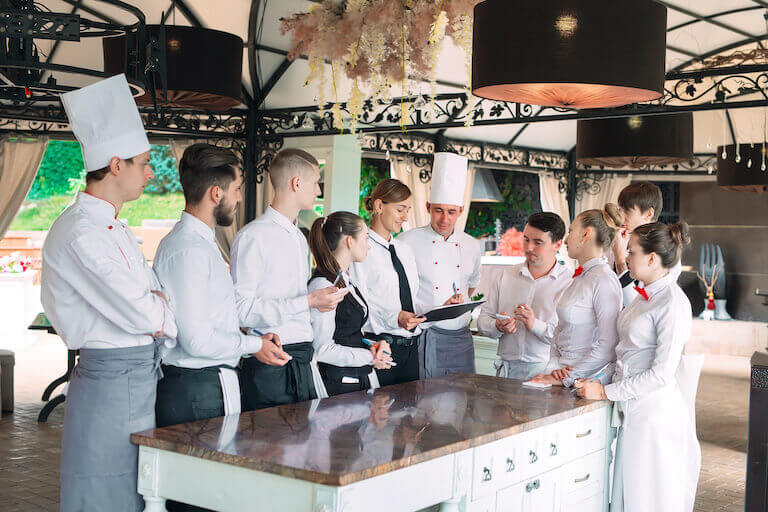Listen to This Article:
Top restaurant managers and owners know there’s a lot more to running a restaurant than good food. And the best chefs know they can’t churn out consistently delicious plates by themselves. That begs the question of how many people it takes to run a restaurant.
Hiring and managing employees is a crucial part of restaurant planning, as labor can be one of the biggest expenses in any culinary operation. In this article, we’ll discuss some of the key factors that could impact the number of employees you may need, and we’ll also go over some rough numbers to help you plan your costs.
Let’s explore the optimal number of staff members required to efficiently operate a restaurant, considering factors such as the restaurant’s size, cuisine type, service style, and expected customer traffic.
The Factors That Impact Restaurant Staffing Needs
The exact number of employees needed to run any food service establishment may depend on the number of guests served at a time (also called “covers”), the complexity of the menu, and your business’ service style. In general, the more high-end the restaurant, the greater the employee-to-guest ratio. This is because fine dining restaurants have more “touch points” than casual service. Touch points are the steps of service that the staff could be expected to complete at every table. These can include things like check-ins, replacing silverware between courses, bringing hot towels, and more.
There may also be roles in some restaurants that aren’t needed in others. A counter service restaurant typically needs a cashier, but a full service restaurant probably won’t. And while a sommelier may be a key part of a fine-dining Italian restaurant, this professional might be very out of place in a casual neighborhood cafe!

Larger restaurants may employ specialized personal like sommeliers
When planning your staffing needs, make sure to take your total weekly shifts into account. A full service restaurant that serves lunch and dinner seven days per week has 14 total shifts. So you’ll need enough front of house and back of house staff to cover the two daily shifts And if you serve breakfast or are open 24/7, you may actually have 21 weekly shifts to cover, in three eight-hour shifts per day. So you’ll need enough staff members to cover each of those shifts while still giving them a couple of days off per week.
How Many Employees Does It Take to Run a Food Truck?
~2-8 total employees
The small size and counter service style of a food truck means that it can usually be run with a small crew. The executive chef is typically responsible for the menu and managing the rest of the cooking staff. If you own your own food truck, you may do this management role yourself, or you may choose to hire outside help. Depending on the size of your truck, you may only be able to fit two or three cooks and/or chefs in the space at a time. But if you’re open seven days per week, you’ll probably need additional cooks to cover all of the shifts.
Some food trucks ask one of the cooks to do double duty as an order-taker and cashier. This delegation of responsibilities can certainly work, especially if your food comes together quickly. But busier trucks will likely need a dedicated cashier on each shift so they can handle the ordering and payment while the cooks focus on the food.

A food truck’s small space means a low number of employees
How Many Employees Does It Take to Run a Counter Service Restaurant?
~8-15 total employees
In a counter service restaurant, you don’t need servers to wait on tables. Instead, orders are placed at the counter, and the guests come to pick up their food when their name or order number is called. This service style helps to keep the number of employees down.
Back of House Employees in a Counter Service Restaurant
In the kitchen, you’ll usually have an executive chef along with a sous chef or lead line cook supervising the rest of the kitchen team. Depending on the size of the restaurant, you could have three to five line cooks (or more), as well as a dishwasher. There may also be a few prep cooks who chop, portion, and complete pre-shift preparation, like making sauces or dressings.
Front of House Employees in a Counter Service Restaurant
In the front of house, you’ll need at least one cashier to take orders, with more on busy shifts. You’ll also need someone to clear and clean the empty tables when the guests are gone. This could be a dedicated busser, or it might be the cashier or even a dishwasher, doing double duty.
There should also be a manager or supervisor on each shift. Aside from ensuring things run smoothly, managers will also be responsible for tasks like purchasing, end of day financials, and payroll.

Take the Culinary Career Survey
We’ve compiled a checklist of all of the essential questions into one handy tool: career options, culinary interest surveys, educational opportunities, and more.
How Many Employees Does It Take to Run a Casual Full Service Restaurant?
~10-40 total employees (or more, for a large restaurant)
A full service restaurant provides a seated meal, which means servers take orders and deliver food and drinks to the table. Your full service restaurant may also have a bar, which will add to your staffing needs.
Back of House Employees in a Casual Full Service Restaurant
The kitchen hierarchy will have an executive chef at the top, as well as a sous chef or lead line cook. Expect staffing approximately three to five line cooks per shift, and a similar number of prep cooks. In a larger restaurant, you may have more. You’ll also need a dishwasher on each shift. A good starting estimate is to assume approximately four back of house employees per 50 guests in a casual restaurant.
Front of House Employees in a Casual Full Service Restaurant
In the front of house, you may be able to schedule one server per five or six tables. If you have a multi-step service process, or offer table-side actions like making guacamole, you may need more servers to make sure your customers get prompt service.
If you have a bar, you’ll need bartenders to make drinks and serve guests at the bar top. Most bars can accommodate two to three bartenders per shift. Full service restaurants often have a host stand as well, to manage the flow of guests and make sure servers don’t get tasked with too many tables at once. The host stand can run with a single host, or may need up to four in a large, busy restaurant.
Don’t forget the management team! A general manager can pull it all together, and a small team of floor managers helps to cover each shift.
How Many Employees Does It Take to Run a Fine Dining Restaurant?
~12-40 total employees
Fine dining restaurants have the highest staffing needs per guest of all restaurants. Because of their higher price point, they are expected to perform at an incredibly high standard. They also employ more specialization, both in the back of house and front of house. At the same time, these restaurants tend to seat fewer people. So while your fine dining restaurant may have more staff per guest, you may also have fewer total employees than a casual dining restaurant.
At fine dining restaurant Ever in Chicago, Chef Curtis Duffy has a crew of approximately 40 employees for only 14 tables!
Back of House Employees in a Fine Dining Restaurant
Expect to see more specialized kitchen employees in a fine dining restaurant—this is where the brigade de cuisine really shines. After the executive chef and the sous chef, there may be a pastry chef, as well as a garde-manger to run the cold station. There could be additional specialists for sauces, fish, or niche dishes like sushi.
There is also a crew of line cooks, often between three and eight depending on the size of the restaurant. Estimate around six kitchen employees per 50 guests in a fine dining restaurant.

Restaurants not only need front of house employees, but also a manager to led them
Front of House Employees in a Fine Dining Restaurant
Because of the high service level, fine dining servers usually only take three to four tables at a time. And they may have additional help, like back waiters who serve water and bread, as well as food runners.
Fine dining restaurants may also have a sommelier who makes wine recommendations. And they’ll have a professional host staff to seat guests and manage the wait list. In some high end restaurants, a manager actually runs the host stand to ensure that guests get a top notch experience from the moment they enter the restaurant.
At the bar, there may be two or three bartenders to serve bar guests and make drinks for the dining room guests. There could also be a barback to restock juices, garnishes, and liquor, and help the bartenders to wash glassware.
Expect to have multiple managers scheduled for each shift as well, so that there’s always someone to talk to a guest if necessary. Fine dining restaurants must be excellent at customer service, and that level of personalization requires a lot of staff!

Filling a variety of roles can help a restaurant succeed
Every Restaurant Is Different!
Keep in mind that these numbers are only estimates, and you’ll need to figure out your unique answer to how many people it takes to run a restaurant. Some restaurants with unusual service models may have a completely different number of staff members. In a hibachi grill, the guests sit at a cooktop, and the cook and server roles are combined in one person. And at a tiny omakase sushi restaurant, the entire staff could just be two people—the sushi chef and a drink server. So consider these estimates to be a starting point as you work on your business plan.
If you’re interested in learning more about restaurant operations, a degree in Hospitality & Restaurant Operations Management from Auguste Escoffier School of Culinary Arts could be the perfect place to start! This online training dives deep into service, management, leadership, and more. Explore how this 60-week training can help you achieve your goals by contacting us today!
To learn more about running a restaurant, try these resources next:
- How Much Does It Cost to Start a Restaurant?
- How Restaurants Get Michelin Stars: A Brief History of the Michelin Guide
- Positioning Statements for Restaurant Marketing
This article was originally published on November 11, 2021, and has since been updated.
*Information may not reflect every student’s experience. Results and outcomes may be based on several factors, such as geographical region or previous experience.

